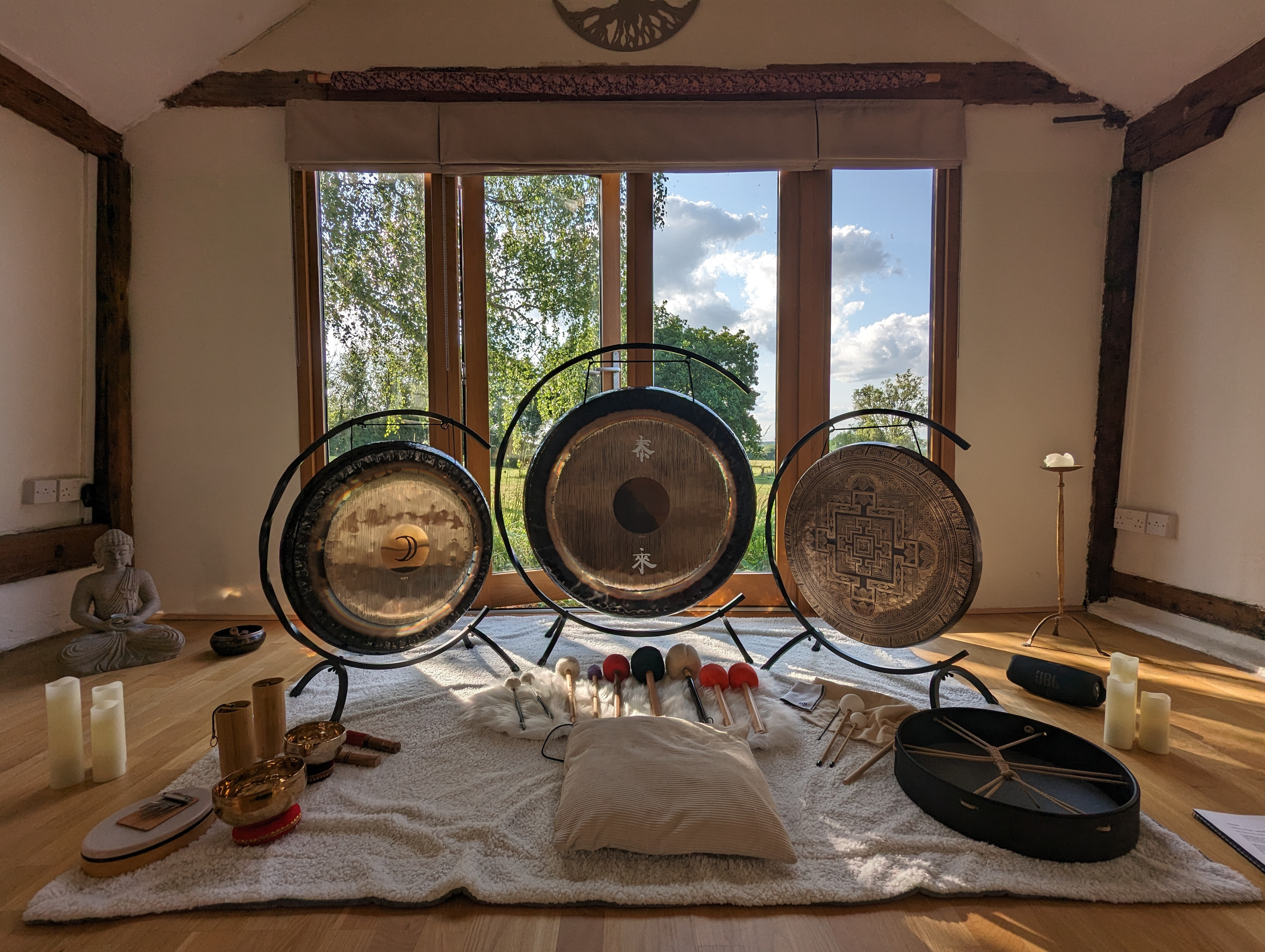A gong bath entails participants immersing themselves in the resonant sound waves generated when a practitioner strikes a gong with a mallet. This “bath” is believed to relieve stress and encourage profound relaxation and rejuvenation.
Baths are often a go-to in many self-care regimens. Soaking in a warm, steamy tub is a familiar way to decompress after a busy day.
Gong baths offer a similar attraction, but they require no water and participants remain fully clothed. Through sound, a gong bath may deliver comparable stress-reducing effects to a traditional soak.
Read on to discover more about gong baths, their possible advantages, and ways to find or create one.
What are gong baths?
Gong baths are a form of passive meditation in which you “bathe” in the therapeutic vibrations of sound.
The use of sound for healing goes back to ancient traditions. A gong bath, sometimes called gong meditation, is a type of sound healing intended to provide relaxation or emotional release.
You can take part in a gong bath individually or in a group setting. Sessions usually last from about 45 minutes up to 2 hours.
During a gong bath, participants typically recline and make themselves comfortable with blankets and pillows. A facilitator strikes the gong — a circular percussion instrument — with a mallet, and attendees passively absorb the sound’s effects.
It’s called a “bath” because participants are figuratively submerged in the instrument’s vibrations throughout the session.
Gong bath experiences may be offered live in person, streamed online, or accessed via recordings of gong performances.
What are the benefits of gong baths?
Like other sound-based therapies, gong baths can help the brain shift into a theta-dominant brainwave pattern, which is linked with deep relaxation and meditative states.
This brainwave pattern commonly appears during the transition between wakefulness and sleep. Beyond relaxation, it may support increased creativity and improved memory processing.
In research on singing bowl meditation that included gong use, participants reported reductions in tension, anger, and fatigue, possibly reflecting dampening of the fight-or-flight response.
In a 2015 study of 129 people who attended sound baths featuring gongs in Slovenia, respondents described the vibrational effects as therapeutic and/or calming. They reported sustained inner calm, enhanced physical and mental well-being, renewed motivation for work, and increased interest in personal development, among other favorable outcomes.
A more recent 2024 study also supported the notion that singing bowls can positively affect mood, tension, and overall well-being.
Gong baths and sound baths: What’s the difference?
The phrases “gong bath” and “sound bath” are often used interchangeably. The main distinction lies in the type of sounds and instruments used.
Both gong baths and sound baths employ sound to foster deep relaxation and a calm state of mind. A sound bath may include crystal or Himalayan singing bowls and various other instruments, whereas a gong bath typically centers on gongs.
Are there any precautions you should take?
Participating in gong baths is generally safe for most individuals across ages and fitness levels.
However, they might not be appropriate for people with certain mental health conditions.
Gong baths may also be unsuitable during pregnancy or for those with epilepsy or seizure disorders. They can potentially cause discomfort for people using hearing assistive devices or who have significant hearing impairments.
Before joining a gong bath, it’s wise to consult a healthcare professional to confirm it’s a safe choice for you.
How to find a gong bath
In-person gong bath sessions are commonly hosted at:
- yoga studios
- meditation centers
- health spas
Live events are also provided via video platforms like Zoom, and many practitioners stream sessions on Instagram. If you prefer practicing at home, several apps offer gong bath recordings.
How to create a gong bath at home
It’s simple to set up a calming gong bath experience in your own space.
Set the mood
First, prepare a soothing environment and atmosphere. Pick a room where you won’t be interrupted and close windows and doors.
Create dim or low lighting by drawing curtains, lowering the lights, or lighting candles. You might burn calming incense or use an essential oil diffuser for added relaxation.
Get comfortable
You may prefer to lie on a yoga mat on the floor or on your bed or couch. Place a pillow under your head for comfort or beneath your knees to support your lower back.
An eye pillow can increase darkness and deepen relaxation; if you don’t have one, draping a scarf over your eyes can work similarly.
Wear comfortable clothing such as leggings, loungewear, or pajamas. Stay warm with socks or a cozy sweatshirt.
Pick the recording or live gong session you want to listen to and arrange your headphones or speakers for optimal sound.

Calm the mind
Once your space is arranged, lie beneath a blanket and close your eyes. Starting with a breathing practice may center your mind, ground your body, and help you fully benefit from the session.
For instance, try alternate nostril breathing or equal-count breaths.
Then release controlled breathing and simply surrender to the sound.
Take your time
When the sound concludes, wiggle your fingers and toes very gently. Allow time for gentle stretches that feel good to you.
When you’re ready, roll onto your right side briefly and rest in a fetal position before sitting up.
Have a glass of water and move into the remainder of your day with a sense of calm. If you completed a sound bath before bedtime, you may be ready to fall asleep right away.
The bottom line
Whether practiced at home or at a live event, alone or with others, a gong bath can support relaxation, restoration, and resetting.
Instead of soaking in water, you lie fully clothed under a blanket and immerse yourself in the sound vibrations produced when a facilitator strikes a gong with a mallet.
Consider incorporating regular gong baths into your self-care routine to help unwind and recharge.


















Leave a Reply
You must be logged in to post a comment.